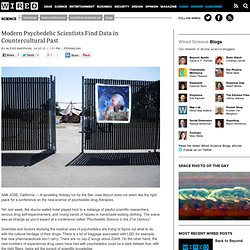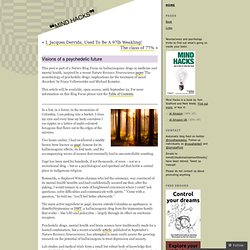

Modern Psychedelic Scientists Find Data in Countercultural Past. SAN JOSE, California — A sprawling Holiday Inn by the San Jose Airport does not seem like the right place for a conference on the new science of psychedelic drug therapies.

Yet, last week, the stucco-walled hotel played host to a mèlange of playful scientific researchers, serious drug self-experimenters, and roving bands of hippies in handmade-looking clothing. The scene was as strange as you’d expect at a conference called “Psychedelic Science in the 21st Century.” Scientists and doctors studying the medical uses of psychedelics are trying to figure out what to do with the cultural heritage of their drugs. There is a lot of baggage associated with LSD, for example, that new pharmaceuticals don’t carry: There are no Jay-Z songs about Zoloft. On the other hand, the vast numbers of experiences drug users have had with psychedelics could be a dark dataset that, with the right filters, helps aid the pursuit of scientific knowledge.
“Things were so polarized in the ’60s. Fire Erowid agreed. On the Use of Psychedelics for Psychiatry - Alexis Madrigal - Technology. Visions of a psychedelic future. This post is part of a Nature Blog Focus on hallucinogenic drugs in medicine and mental health, inspired by a recent Nature Reviews Neuroscience paper ‘The neurobiology of psychedelic drugs: implications for the treatment of mood disorders’ by Franz Vollenweider and Michael Kometer.

This article will be available, open-access, until September 23. For more information on this Blog Focus please visit the Table of Contents. In a hut, in a forest, in the mountains of Colombia, I am puking into a bucket. I close my eyes and every time my body convulses I see ripples in a lattice of multi-coloured hexagons that flows out to the edges of the universe. Can psychedelics have a role in psychiatry once again? BEN SESSA, MBBS, BSc, MRCPsych + Author Affiliations DECLARATION OF INTEREST None. Psychedelic or hallucinogenic drugs such as lysergic acid diethylamide (LSD), 3,4,5-trimethoxy-β-phenethylamine (mescaline), psilocybin, 3,4-methylenedioxymethamphetamine (MDMA), N,N-dimethyltryptamine (DMT) and their relations occur in abundance throughout the natural world, and have been used by humankind for thousands of years. In some cultures they are important tools for spiritual experiences, whereas in others they are labelled as dangerous drugs of misuse. What is less well known about these substances is the role they played in psychiatry for a brief historical interval.
Despite their history, psychedelics have dropped out of psychiatric dialogue for today's trainee psychiatrists (Strassman, 2001). Yet in the years between the first synthesis of LSD in the 1930s and the disappearance of psychedelic research by the late 1960s, there was a furious growth of scientific interest in these substances.